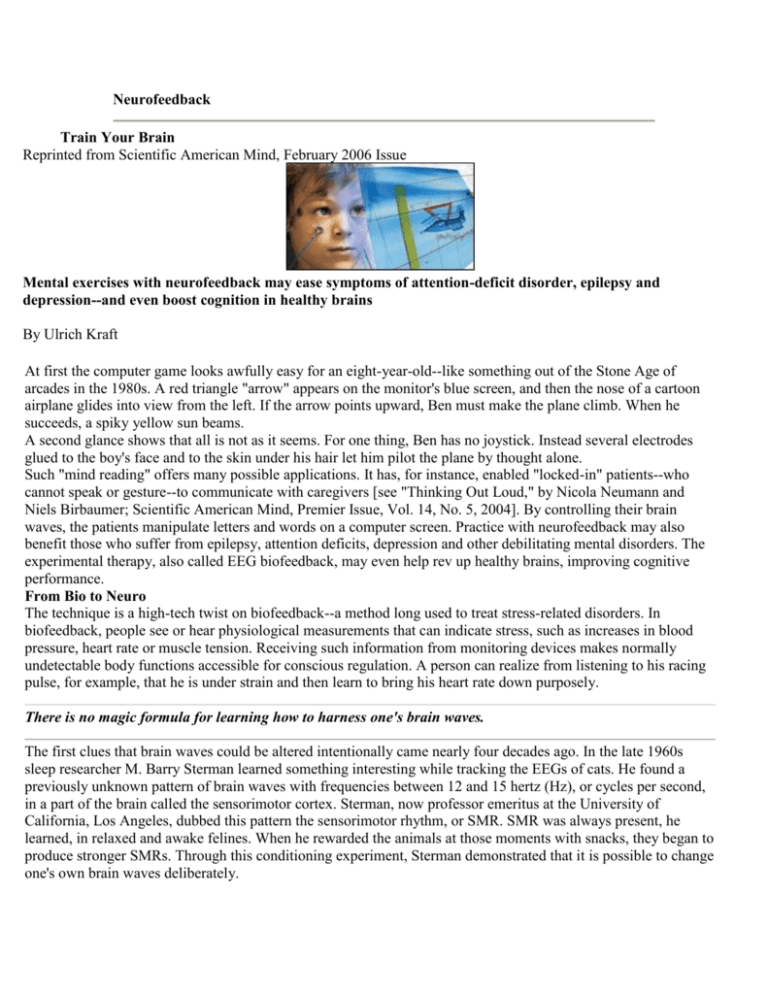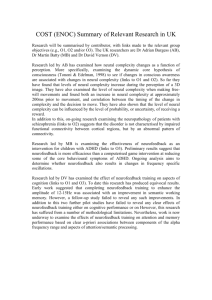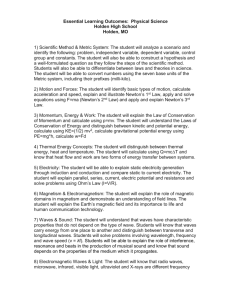EEG Neurofeedback article scientific am
advertisement

Neurofeedback Train Your Brain Reprinted from Scientific American Mind, February 2006 Issue Mental exercises with neurofeedback may ease symptoms of attention-deficit disorder, epilepsy and depression--and even boost cognition in healthy brains By Ulrich Kraft At first the computer game looks awfully easy for an eight-year-old--like something out of the Stone Age of arcades in the 1980s. A red triangle "arrow" appears on the monitor's blue screen, and then the nose of a cartoon airplane glides into view from the left. If the arrow points upward, Ben must make the plane climb. When he succeeds, a spiky yellow sun beams. A second glance shows that all is not as it seems. For one thing, Ben has no joystick. Instead several electrodes glued to the boy's face and to the skin under his hair let him pilot the plane by thought alone. Such "mind reading" offers many possible applications. It has, for instance, enabled "locked-in" patients--who cannot speak or gesture--to communicate with caregivers [see "Thinking Out Loud," by Nicola Neumann and Niels Birbaumer; Scientific American Mind, Premier Issue, Vol. 14, No. 5, 2004]. By controlling their brain waves, the patients manipulate letters and words on a computer screen. Practice with neurofeedback may also benefit those who suffer from epilepsy, attention deficits, depression and other debilitating mental disorders. The experimental therapy, also called EEG biofeedback, may even help rev up healthy brains, improving cognitive performance. From Bio to Neuro The technique is a high-tech twist on biofeedback--a method long used to treat stress-related disorders. In biofeedback, people see or hear physiological measurements that can indicate stress, such as increases in blood pressure, heart rate or muscle tension. Receiving such information from monitoring devices makes normally undetectable body functions accessible for conscious regulation. A person can realize from listening to his racing pulse, for example, that he is under strain and then learn to bring his heart rate down purposely. There is no magic formula for learning how to harness one's brain waves. The first clues that brain waves could be altered intentionally came nearly four decades ago. In the late 1960s sleep researcher M. Barry Sterman learned something interesting while tracking the EEGs of cats. He found a previously unknown pattern of brain waves with frequencies between 12 and 15 hertz (Hz), or cycles per second, in a part of the brain called the sensorimotor cortex. Sterman, now professor emeritus at the University of California, Los Angeles, dubbed this pattern the sensorimotor rhythm, or SMR. SMR was always present, he learned, in relaxed and awake felines. When he rewarded the animals at those moments with snacks, they began to produce stronger SMRs. Through this conditioning experiment, Sterman demonstrated that it is possible to change one's own brain waves deliberately. The researcher might well not have followed up on this discovery. But at roughly the same time, he received a request from the U.S. Air Force, which wanted him to test the potential cognitive effects of exposure to monomethylhydrazine, a substance used in some rocket fuels and known to cause seizures. Sterman injected the chemical into cats. About an hour afterward, most of them suffered a seizure. In a few of the subjects, however, the seizure's onset occurred considerably later than usual; three others escaped the convulsions entirely. Seeking an answer for the resistance, Sterman examined his experimental protocol. He observed that the resilient cats had one thing in common: they had previously been involved in his conditioning tests. Could their ability to control their SMR waves have been a factor? Sterman pursued the question in further experiments. In the early 1970s he found indications that people with epilepsy also could reduce their risk of seizures if they learned to heighten their SMR levels. Yet the idea remained controversial for lack of thorough study. Brain Control More than 30 years after Sterman's initial work with SMRs, scientists are exploring how neurofeedback might be used to treat a variety of ailments. In addition to SMRs, other brain waves at different frequencies characterize certain mental states [see illustration on page 63]. In deep sleep, for example, delta waves, with frequencies of up to 4 Hz and high amplitudes, dominate. Frequencies around 10 Hz, known as alpha waves, are present in a relaxed but awake brain; they emerge, for example, when we lie back with our eyes closed. If we then begin to concentrate on something, beta waves, with frequencies greater than 13 Hz, travel across the cortex. Lowerfrequency theta waves appear when the brain relaxes. Theta waves, with high amplitudes and frequencies falling between those of delta and alpha waves, normally appear in adults during light sleep and meditation. Regardless of frequency, there is no magic formula for learning how to harness one's brain waves. "Each subject must discover his own individual strategy, by trial and error," Leins explains. To increase brain activity, which steers the video plane upward, many children in the Tuebingen experiment say they think about something exciting--like jumping off a diving board. Ben imagines that he is spending a night camping in the woods. If the directional arrow points down, the boy tries to calm his brain to make the plane dip; in his thoughts, he lies down in bed and naps. At Tuebingen, researchers working on epilepsy therapy are looking at yet another component of the EEG, called slow cortical potential, or SCP. These brain waves can indicate activity in the cortex. Detecting them is useful, because epileptic seizures begin with overexcitement in cortical neurons, usually in a very limited area, from which brain activity spreads uncontrollably. The SCPs of patients shift in an electrically negative direction just before a seizure. Such negative slow potentials also arise normally in the brain. Therefore, the goal of neurofeedback is for patients to come to recognize this onset of electrical negativity and then to push their SCPs in the positive direction. Patients learn to limit brain activity consciously, thus suppressing an epileptic attack. The method seems promising. In a 2001 study Niels Birbaumer and his colleagues at Tuebingen worked with epileptics who had not been helped by conventional medical therapies. On average, patients using SCP neurofeedback were able to reduce the number of seizures they suffered by a third. The positive effects lasted long after the training sessions had ended. Mental Aerobics Beta waves are the target of therapies for children with attention-deficit hyperactivity disorder, or ADHD. "It is exactly these higher-frequency brain waves that are, in children with ADHD, weaker compared with those in healthy children," Leins states. In the U.S., more than 700 groups are using EEG biofeedback to treat ADHD, according to the Association of Applied Psychophysiology and Biofeedback. Children with ADHD struggle with schoolwork and social skills because they are restless, impulsive and have difficulty concentrating. Reduced levels of the higher-frequency brain waves are especially noticeable in the prefrontal cortex, an area involved in attention control. The kids also have an increase in lower-frequency waves, especially theta waves from 4 to 7.5 Hz. With neurofeedback, Leins says, "our ADHD subjects train their brains to produce fewer theta waves and thereby more beta waves." Today Ben makes 45 "hits"--times when he has successfully lifted or lowered his brain activity at will. He gets five points on a gift card, and then he is free to leave. His mental exercises are not over for the day, however. Ben has been told to practice brain control in his everyday life, too. Before beginning homework, for example, he is to first imagine sinking a couple of baskets. Revving up the brain in this manner seems to help kids like Ben focus. "Many children say they can concentrate better after it and complete their homework more quickly," Leins says. After the sessions, the subjects performed better on evaluations of their attention and intelligence. Children in the Tuebingen experiment train for 30 hours. The researchers measure their cognitive performance immediately before and after treatment, using standardized tests especially geared to monitor attention. Six months after the therapy, they are checked again. After the neurofeedback sessions, the subjects performed better on evaluations of their attention and intelligence. Teachers reported that they were quieter and less impulsive in class. Many parents also said that their children had fewer problems doing homework. Leins sees these results as positive, though not definitive. "What we still lack are controlled studies of many children, which would compare this technique with other therapeutic methods," the researcher says. Balancing Act Many mental illnesses are accompanied by unusual brain-wave patterns, a fact that offers another possible therapeutic application for neurofeedback. Whether these variations are the cause or effect of such disorders is not always clear. At the least, the presence of such uncommon patterns may hinder recovery. In the early 1990s, for example, Richard J. Davidson, professor of psychology and psychiatry at the University of Wisconsin-Madison, noticed unusual asymmetries in the brain-wave patterns of people with depression. Apparently the distribution of alpha activity between the anterior parts of the right and left hemispheres can be associated with mood. Among depressive subjects, the pendulum swung to the right; their left hemispheres were comparatively less active. With that in mind, psychologist J. Peter Rosenfeld of Northwestern University is trying to ease depression with neurofeedback. If patients could correct their own brain-wave patterns, Rosenfeld posits, they might be able to lift the gloom from their minds. So he and psychologists Elsa Baehr and Rufus Baehr of the NeuroQuest Neurofeedback Center in Evanston, Ill., developed a neurofeedback training program in the mid-1990s. Whenever the amplitude of alpha waves in the left frontal cortex rose above that in the right, the participants would hear a pleasant note played on a clarinet. During sessions lasting 15 to 30 minutes, the subjects worked to learn how to keep the tone in their ears for increasingly longer periods. One spectacular case involved a woman who had previously been treated for recurrent bouts of depression for 12 years, without success. After just 35 hours of training, in combination with psychotherapy, her symptoms decreased drastically. In the subsequent six-year tracking period, she remained free of depression. Although the scientists can also point to successes with EEG feedback among other patients with depression, Elsa Baehr urges caution. "This is an experimental protocol," she notes. "Until there are controlled studies, we won't know how effective the therapy is." Brain Boost? In addition to therapies, could neurofeedback improve cognition in healthy brains? NASA, for one, has been using EEG biofeedback for years to increase concentration in its pilots. To find out more, psychologist David Vernon, now at Canterbury Christ Church University in England, asked 40 volunteers to come to his lab. He and others wanted to find out whether deliberately influencing certain brain-wave patterns could boost working memory--which temporarily stores and manages information required to carry out complex cognitive tasks such as learning or reasoning. He first presented his subjects with a list of words. Then he gave them a category, such as "animals," and asked them to recall as many words from the list as possible that fit into that grouping. Before training, the participants were able to remember just 71 percent of the words. In eight sessions, they learned to strengthen their SMRs--the same patterns that Sterman had worked with. After training, Vernon tested his subjects again, and this time they could remember almost 82 percent of the words. Vernon's group announced the results in January 2003. "Here we have the first evidence of a connection between neurofeedback and improvement in memory," Vernon claims. A study published in 2003, carried out at Imperial College London, supports the notion that brain-wave training can improve cognition. Neuroscientists Tobias Egner, now at Columbia University, and John H. Gruzelier recruited test subjects at the Royal College of Music, London's elite school for promising young musicians. Some of the subjects learned, via feedback on a computer screen, how to control the slow waves in the alpha and theta ranges. After neurofeedback, the musicians' abilities had grown enormously, according to expert evaluators. The improvements came in such various areas as musical understanding, stylistic precision and imaginative interpretation. What is more, the students made significantly fewer mistakes. If further experiments confirm such results, neurofeedback may offer a suite of applications. Gruzelier, for example, is considering how SMR reinforcement could be used to train people whose professions require exceptionally steady hands, such as eye surgeons. ULRICH KRAFT, a physician and regular contributor to Gehirn & Geist, is a freelance science writer in Berlin






